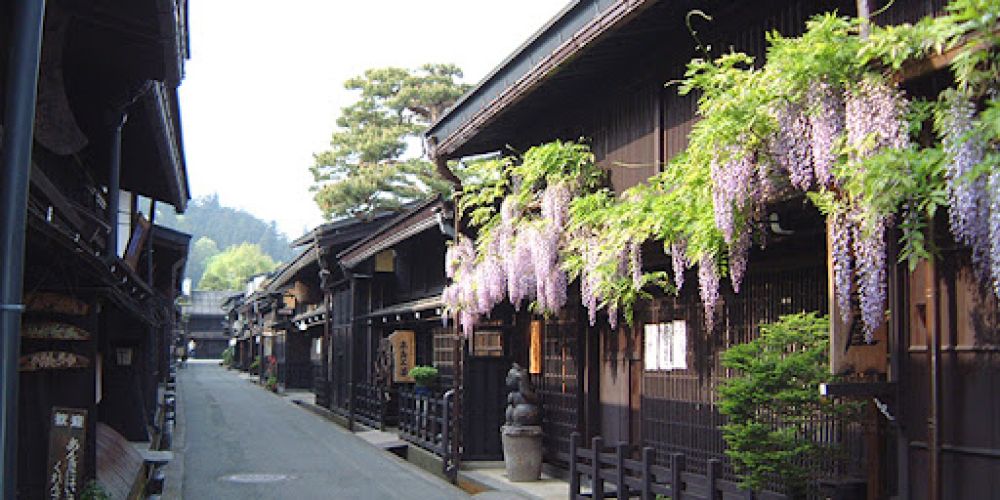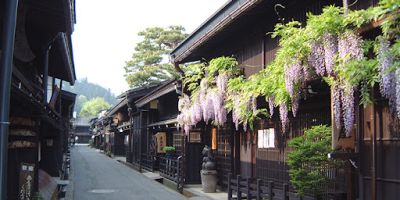

Hida Folk Village, or Hida no Sato, is an open-air museum in Takayama that offers a peek into Japan’s traditional Edo period with over 30 thatched-roof houses from the Hida region. Walking around the village, visitors can explore large farmhouses that display unique architecture, designed to withstand heavy snowfalls. Inside, you'll find dark and cozy interiors with irori fireplaces and exhibitions of folk art and everyday artifacts, giving insight into the customs and lifestyles of the past. Crafts demonstrations and hands-on activities, such as sarubobo doll making, are also available for a truly immersive experience. The setting is especially beautiful during sakura season when the cherry blossoms are in full bloom, or in autumn when the leaves turn brilliant hues.
The Takayama Morning Markets are a delightful way to experience the local culture and daily life. The two main markets, Jinya-mae Market in front of the Takayama Jinya, and the Miyagawa Market along the Miyagawa River, are open from dawn until noon. Here, visitors can browse through a wide array of local crafts, snacks, and fresh produce, including Takayama's famous pickles. The markets are also a great place to find unique souvenirs, such as sarubobo dolls, Hida beef-related products, and Sake. Visiting the morning markets is an opportunity to mingle with the friendly locals and maybe even sample some of their homemade products. The lively atmosphere, combined with the scent of fresh foods and sounds of bustling trade, makes for a delightful sensory experience that's not to be missed.
Takayama's Old Town, known as Sanmachi Suji, is famous for its beautifully preserved Edo period streets which seem to transport visitors back in time. A guided walking tour can enhance this experience by providing insights into the history and culture of the area. As you wander past traditional merchant homes, local museums, and sake breweries, you'll learn about the local crafts of carpentry which flourished due to the demand for skilled craftsmanship in building temples and shrines. A highlight of the tour could be a sake tasting experience at one of the old breweries, where the cold climate is perfect for sake production. The Old Town is particularly enchanting in the evening when the lanterns are lit and the crowds have thinned, providing a quiet, atmospheric stroll.
The Takayama Festival Floats Exhibition Hall, located near Sakurayama Hachimangu Shrine, is a must-visit to appreciate the artistry and craftsmanship of the region. Takayama is renowned for its festivals in spring and autumn, where elaborately decorated floats, some several hundred years old, are paraded through the streets. When not in use, they are housed in this exhibition hall. Each float is a lavishly adorned masterpiece covered in intricate carvings, metalwork, and lacquer. Some even have mechanical dolls (karakuri) that can move and perform. A visit here not only allows one to admire these historical pieces up close but also offers a glimpse into the community’s pride and the continuing tradition of craftsmanship. The adjacent video room explains more about the festivals, offering a fuller understanding of this important cultural heritage.
The Hida Takayama Museum of Art is nestled in the scenic locale of Takayama and boasts a remarkable collection of European glass art alongside Japanese glasswork, giving visitors a comprehensive look at the beauty and craftsmanship of the medium. Notably, the museum showcases works by Emile Galle, a master of French Art Nouveau glass, and Rene Lalique, known for his Art Deco creations. In addition to glass, the museum also offers displays of fine porcelain and contemporary furniture. The European-style building itself, with its Art Nouveau inspired architecture, complements the collections within. Throughout the museum, visitors can find exhibits that are not only visually stunning but also provide a narrative of the evolution of glass art over time. The adjoining garden, which reflects the changing seasons, compleates the aesthetic experience of the museum visit.
A trip to Takayama is not complete without venturing out to the UNESCO World Heritage site of Shirakawa-go, famous for its traditional gassho-zukuri farmhouses, some of which are over 250 years old. The name gassho-zukuri means 'constructed like hands in prayer,' as the steep thatched roofs resemble the hands of Buddhist monks pressed together in prayer. During a day trip, visitors can explore the largest farmhouse, Wada House, acting as a museum, and immerse in the history and culture of this unique village set in a picturesque mountainous region. Many of these houses are still inhabited, and some have been converted into guesthouses, shops, or restaurants, providing an authentic experience for visitors. The landscape is particularly lovely in winter when the village is covered in snow, contrasting sharply with the dark wood of the farmhouses.
Hida beef, the region’s specialty, is known for its marbling, tenderness, and exquisite flavor. Enjoying a meal featuring this premium beef is a must-do activity for foodies. At a local restaurant, diners can savor Hida beef in a variety of styles, including grilled as yakiniku, skewered as kushiyaki, or even as high-quality sushi. Many establishments offer the experience of cooking the meat at your table on a magnolia leaf, providing not just a delicious meal but also an interactive culinary adventure. The indulgence in the melt-in-the-mouth texture coupled with a sake pairing makes for a memorable gastronomical experience, showcasing the best of Takayama's local produce and culinary traditions.
Takayama Jinya served as a local government office during the Edo period and is the only building of its kind remaining in Japan. Now a national historic site, it offers a rare glimpse into feudal administration and life of the era. Visitors to Takayama Jinya can tour the offices, interrogation rooms, and residential spaces, providing a comprehensive look at the bureaucratic workings of the past. Of particular interest is the rice storehouse, which is the oldest building in the complex and demonstrates the importance of rice as a form of currency and power during the period. The interior is rich with historical artifacts and well-preserved tatami rooms, some featuring original documents and furnishings from the time.
Immerse yourself in the cultural heritage of Takayama by participating in traditional crafts workshops. These sessions offer a hands-on experience in creating local handicrafts such as sarubobo dolls, shunkei lacquerware, or ichii-itto-bori (Japanese yew wood carving). Under the guidance of skilled artisans, workshop attendees can learn about the techniques passed down through generations and create their unique souvenirs to take home. The city's longstanding tradition of woodwork can be felt in the precision and care that goes into each piece, whether it's carved figurines, intricate tableware, or decorative items. Engaging in these workshops not only supports local craftspeople but also provides a meaningful connection to the artistic traditions of Takayama.
Kamikochi, part of the Chubu Sangaku National Park, is a mountainous highland valley and a natural treasure of Japan. This alpine destination offers stunning scenic beauty with breathtaking views of the Northern Japan Alps, pristine azalea-lined rivers, and diverse wildlife. An excursion to Kamikochi typically involves a guided hike along well-maintained trails, suitable for both casual walkers and serious hikers. The journey often includes Taisho Pond, which showcases reflective views of the mountains, and the iconic Kappa Bridge offering panoramic views of the Hotaka mountain range. The serenity of the area, combined with the diverse flora and fauna, makes it a spiritually refreshing place. The spring and autumn seasons display a vivid range of colors that are a particular draw for nature enthusiasts and photographers.
